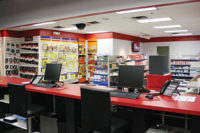
BNP Media co-CEO Taggart Henderson, right, with administrative assistant Janice Bashi. “My brothers and I are fourth-generation executive owners,” he said.
In 1926, F.M. Cockrell started Business News Publishing Co., now BNP Media, in Detroit. The first issue of theElectric Refrigeration News, nowThe Air Conditioning, Heating & Refrigeration NEWS, had a publication date of Sept. 11, 1926. It was created to help recognize the importance of the expanding electric refrigeration market, which would also help perpetuate the use of electricity. It’s no surprise that the two technologies grew up in each other’s shadows.
Looking at the market’s history, we can see why Cockrell wanted to get involved in it when he did. By 1920 there were some 200 different refrigerator models on the market. Steel and porcelain cabinets began appearing in the mid-’20s.The NEWS, of course, appeared in 1926. The first directory was published in 1927.
The fledging publication and publisher weathered the Great Depression by continually working to provide valuable, insightful information to the industry it served. Home refrigerators were becoming status symbols over old-fashioned ice boxes, and the real benefits they provided - convenience, healthier food storage, economy of food dollars - allowed them to grow.
In 1931, the publication frequency increased from every other week, to every week.
When the publication turned 10 years old, in 1936, it became theAir Conditioning and Refrigeration News. Comfort cooling was taking off commercially, having already established itself within some movie theaters, in high-end retailers like J.L. Hudson in Detroit, and in temperature-sensitive industries like candy-making and pharmaceuticals. R-22 had entered the market.
By 1937, more than 2 million Americans owned refrigerators. But that was only the beginning - by 2007, refrigerators were present in 99.5 percent of all American homes, and hailed as one of the most important domestic technological developments of the century.
In 1939, the first all-industry expo took place, created byNEWSpublisher Cockrell.
The year also saw the emergence of World War II. In that one year, Franco’s nationalists won the Spanish Civil War, Germany annexed Czech territories, Italy occupied Albania, Germany occupied Poland, and the USSR attacked Finland. After the U.S. entered the war in 1941,NEWSeditors like Jack Sweet stepped up in service of their country - whileThe NEWSkept publishing.
In 1958, the coverage was extended again and we becameThe Air Conditioning, Heating & Refrigeration NEWS. These days, we are simply known asThe NEWS.
In 1968, the offices were moved from Detroit to Birmingham, Mich. The company has been headquartered in Troy, Mich., since 1979.
LEADING TECHNOLOGY
All along the way, BNP leadership kept its eyes open to the opportunities provided by technological advancements in both the HVACR trade, and in the science and art of publishing itself.The paper was first published on a Linotype machine (which we laughingly refer to as one step up from Gutenberg’s moveable type). The machine’s operator, or compositor, would type in the edited manuscript. This was output as metal type - which needed to be hand assembled with printed elements like graphics, to create a plate. The plates were printed on paper, assembled as a magazine, addressed, and mailed to subscribers.
Cold type, also called phototypesetting, emerged in the 1960s. In this method, edited manuscripts were set as single-column galley proofs. Copies of the proofs and manuscripts went to the proofreaders, who read both at once to check for accuracy to the original. Corrections were made again at the typesetter’s shop, and corrected galleys were returned the next day. Proofreaders checked the corrections, and the galley copies were trimmed and used to create page mockups. From those, the original galleys were cut, waxed, and set as page paste-ups. These became actual pages at the printer.
Computers started to be used in the late ’70s and early ’80s. At first they were little more than glorified typewriters - but what an improvement for the editors who could make corrections without correcting fluid, and run a spell checker! Early file transference was done by passing 5.25-inch floppy disks, later 3.5-inch disks, back and forth.
For a few years,The NEWSwas published by a mixed method that included galley corrections and computerization. Pages at one point were delivered by hand to the printer’s office, on a disk. Page layout and corrections were done on computer.
The growth and increasing commercialization of computer networking eventually made this a nearly paperless process, at least as far as the transfer of files to the printer was concerned. Individual pages are composed at the computer by the art director; the pages are printed for proofreading, and again when page corrections are made. All pages are sent to the printer via the computer.
The availability of today’s articles does not stop with the printed issues. Each week’s issue goes online at www.achrnews.com, with even more information than the print issue includes. The website includes Breaking News, Extra Edition, videos, podcasts, editorial archives, and more.
Initially a publisher of magazines and technical books, BNP Media now serves a broad range of business-to-business customers via multiple media.The NEWSis still proudly leading the way. Today’s subscribers may read us online, on tablets and smart phones, as well as on their PCs - or even holding a printed copy of the publication in their hands.
Publication date:06/27/2011





